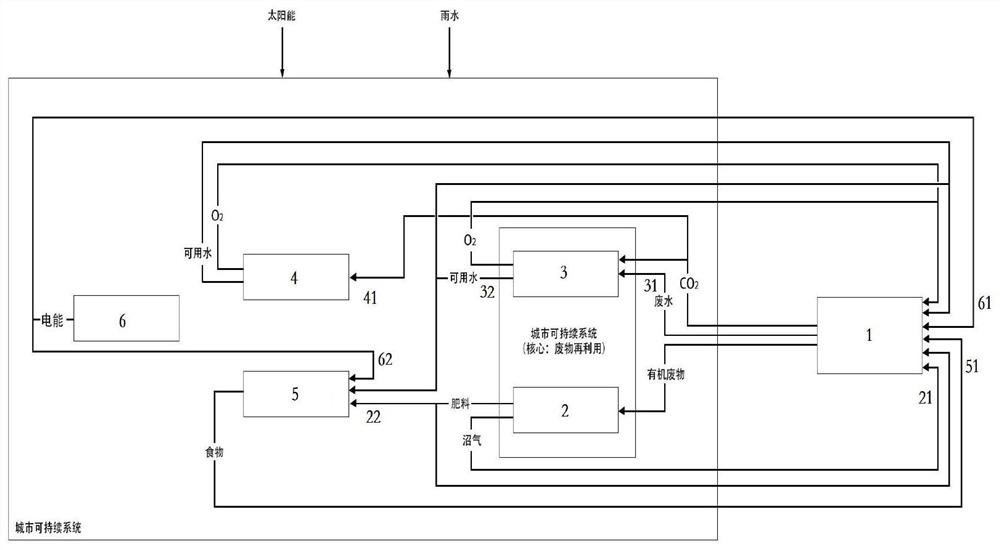Multi-system city self-circulation system
A self-circulation system and a technology of a circulation system, applied in the field of multi-system urban self-circulation system, can solve the problems of lack of energy reuse measures, energy consumption, low utilization rate of urban waste, etc., to achieve sustainable urban operation and reduce resources. Waste rate, good economic effect
- Summary
- Abstract
- Description
- Claims
- Application Information
AI Technical Summary
Problems solved by technology
Method used
Image
Examples
Embodiment 1
[0027] In this example, see figure 1 and figure 2 , a multi-system urban self-circulation system, which is an internal urban circulation system, contains multiple subsystems that can perform material-energy conversion, and realizes sustainable urban operation, including the main body city 1. The urban internal circulation system includes biogas System 2, constructed wetland system 3, rain garden system 4, urban farm system 5 and solar power generation system 6;
[0028] The ontology city 1 is used to realize the basic needs of the residents in the city, and realize sustainable self-circulation operation, which includes input and output of various energies and substances;
[0029] The biogas system 2 is used to degrade the feces and other organic wastes produced in the main city 1 into biogas, carbon dioxide and inorganic nitrogen and phosphorus compounds through microbial degradation;
[0030] The constructed wetland system 3 is used to provide urban clean water, after the ...
Embodiment 2
[0036] This embodiment is basically the same as Embodiment 1, especially in that:
[0037] In this embodiment, the main city 1 is a standard and complete small and medium-sized town area. The downtown area has sound commercial, office, residential, and educational functions, and it is located in a livable environment with sufficient sunlight and rain.
[0038] In this embodiment, the biogas system 2 contains a plurality of energy exchange ports, including a biogas-city exchange port 21 and a biogas-urban farm exchange port 22; the biogas-city exchange port 21 is used for the biogas system of the body city 1 direction 2 transport the generated organic waste, and the biogas system 2 transports the generated biogas and fertilizer to the main city 1; the biogas-urban farm exchange port 22 is used for the biogas system to transport the generated fertilizer to the urban farm system.
[0039] In this embodiment, the constructed wetland system 3 includes a plurality of energy exchange...
Embodiment 3
[0045] This embodiment is basically the same as the above-mentioned embodiment, and the special features are:
[0046] In this example, see figure 1 , this embodiment is an energy-waste urban self-circulation system, which is a sustainable system from the city, including the input and output of various energy forms, and is characterized in that many subsystems use the waste produced by the city and their own attributes , to generate the energy needed for the continuous operation of the city, making it called renewable energy, and there are interfaces between each system and the city, see figure 2 .
[0047] See attached figure 2 , the present embodiment has the design of a multi-system urban self-circulation system, which is an internal circulation system of the city and contains a plurality of subsystems capable of material-energy conversion, with the purpose of realizing sustainable urban operation. It is characterized in that, Including the main body city, biogas syste...
PUM
 Login to View More
Login to View More Abstract
Description
Claims
Application Information
 Login to View More
Login to View More - Generate Ideas
- Intellectual Property
- Life Sciences
- Materials
- Tech Scout
- Unparalleled Data Quality
- Higher Quality Content
- 60% Fewer Hallucinations
Browse by: Latest US Patents, China's latest patents, Technical Efficacy Thesaurus, Application Domain, Technology Topic, Popular Technical Reports.
© 2025 PatSnap. All rights reserved.Legal|Privacy policy|Modern Slavery Act Transparency Statement|Sitemap|About US| Contact US: help@patsnap.com


